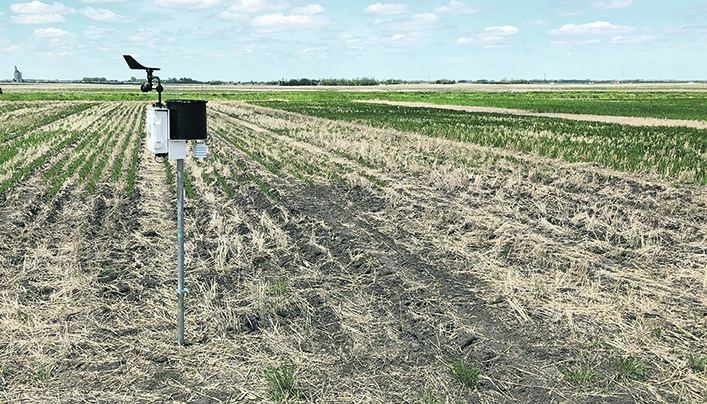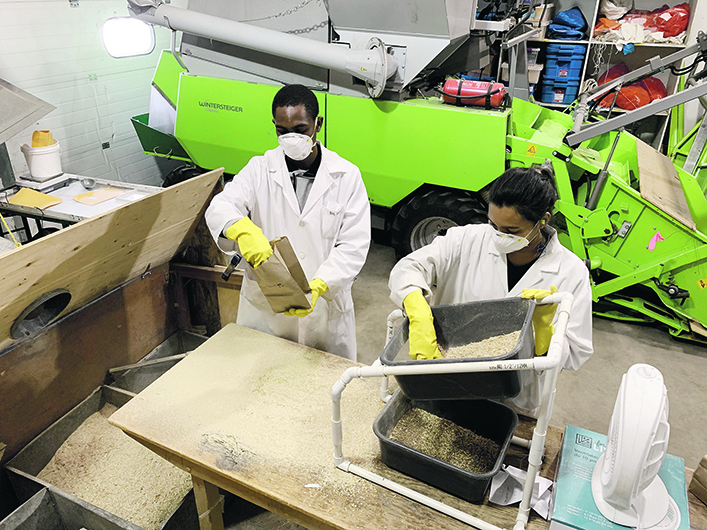Knowing when to treat is a tough call, but a researcher has developed another way of knowing when to apply
Paul Bullock hopes to give farmers an interactive online tool to help farmers decide when and if to spray for fusarium infestation in the narrow window when it is effective.
“You have to apply that control around the time of flowering, just after the wheat is headed,” he said. “You have to be able to make a decision because if you’re not sure, well 10 days later, it’s too late.”
Bullock is a researcher at the University of Manitoba. An agrometeorologist, he specializes in the use of weather and climate knowledge to enhance crop production. He and his colleagues are working to develop an interactive, prairies-wide viewer and mapping tool that draws upon knowledge of both weather and of fusarium itself.
Read Also

Equipment manufacturing may return to Canada
Some ag equipment and automotive manufacturers are now adjusting their production and distribution to avoid tariff costs in relation to supplying the Canadian market.
Of the many species of fusarium fungi found in soils all over the world, only a few cause problems for farmers. Chief among these is fusarium graminearum, which causes fusarium head blight in cereals.
“FG is the major problem however we are seeing fusarium poae to be important in barley,” said University of Manitoba plant pathologist Dilantha Fernando. “Also, some species are more apparent based on the region, such as Manitoba versus Alberta, which is more likely related to the weather.”
Fernando leads the pathology work on the project, which is looking at fusarium in wheat, winter wheat, barley, and durum. His lab is identifying samples of the pathogen and characterizing them by location, species, and chemotype (variations with a species).
“Without the pathogen information the weather models are weak and would not serve the grower well,” Fernando said, adding that weather parameters will vary for different types of fusarium and the characteristics of the crops themselves.
“The crop and pathogen interaction will be different on winter and spring wheat due to different flowering times of the two crops,” he said.
Fusarium infestation has limited growers’ options, especially in the eastern Prairies.
“A lot of them just apply a fungicide at the heading stage,” he said. “You don’t even think about it.”
Further west, where the climate is more arid, the decision is flipped, with producers giving little thought to spraying except for the occasional outbreak in a wet year.
“If you’re in an area where infections are rare, it would be useful to have an indication in those years where it could be a high risk,” Bullock said, by identifying conditions that would make it worthwhile to try to control fusarium.
“You could improve your yield, limit the amount of mycotoxin that might be showing up in your grain sample; there are a whole range of benefits that way as well.”
A tool that could accurately assess the risk of fusarium would help both ends of this spectrum.
To build it, Bullock and his collaborators are gathering data from across the Prairies over three years beginning with 2019. Variables such as sunlight, humidity, wind, temperature and precipitation are fed into the model, as well as dates of flowering and level of fusarium infestation.
“The idea is that if we can identify the critical variables to tell us where the risk is high and low, we can measure those in the field with weather stations,” he said. “Are you at a low, moderate, or a high risk of fusarium, based on the conditions that you measured for weather in your field?”
The researchers are busy analyzing the 2019 data from field plots in five locations in each province, each of which is equipped with its own mini weather station and observed closely for fusarium during the growing season. Harvest from the plots goes to the lab for testing both for the fungus itself and for deoxynivalenol, a mycotoxin it produces.

Information from the field plots is augmented by data from more than 100 sites in the crops of farmers who are participating in the study.
“We’ll get them to leave an area 30 by 30 metres on a side and leave it unsprayed, because we don’t want the spray to confound our results, to see what would happen under the natural weather conditions,” Bullock said.
The researchers observe these set-asides during the growing season, then thresh samples of grain for lab analysis. These results are matched to the nearest weather station.
Weather data comes from extensive government-run networks of stations running in Alberta and Manitoba.
Bullock hopes the private network in Saskatchewan owned by Glacier FarmMedia will also participate. Environment Canada data is also available.
“This wasn’t about adding more weather stations, it’s more about using the weather stations there that are reporting the conditions in real time and we can access and very quickly turn into a risk assessment,” Bullock said.
The next step is to plug all these data into the test model and see if it can accurately predict what actually happened in the field. Bullock and his colleagues have the 2019 data into shape. Information from this crop year is just coming off the fields and there is one more year to go.

Ideally, the team will also want to include information of different varieties which have different levels of resistance to fusarium.
“You need that kind of information in order to tailor it, because if you think you’re just going to have one model to cover everybody it is just not going to be possible,” Bullock said.
Of course, all that data will be invisible, running in the background of the tool.
A beta version of the tool is expected in 2022 with a full release planned after that.
In terms of benefits beyond the costs of spraying fungicides, there are also marketing considerations.
“One of the things we’ve pointed out is that if you’re in the business of producing any kind of food product, consumers are more and more conscious about how you produce,” Bullock said.
“How do you quantify that? I don’t know. But if you can reduce the amount of fungicide you use, the amount of herbicide, the amount of insecticide you use, consumers are going to be more amenable to the product you’re producing.”















